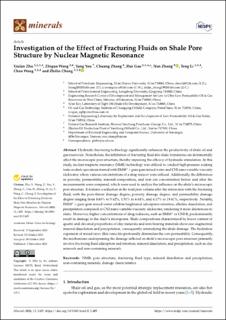| dc.identifier.citation | Zhu, X., Wang, Z., You, Y., Zhang, C., Gao, H., Zhang, N., ... & Cheng, Z. (2023). Investigation of the Effect of Fracturing Fluids on Shale Pore Structure by Nuclear Magnetic Resonance. Minerals, 13(11), 1405. | en_US |
| dc.description.abstract | Hydraulic fracturing technology significantly enhances the productivity of shale oil and gas reservoirs. Nonetheless, the infiltration of fracturing fluid into shale formations can detrimentally affect the microscopic pore structure, thereby impairing the efficacy of hydraulic stimulation. In this study, nuclear magnetic resonance (NMR) technology was utilized to conduct high-pressure soaking tests on shale specimens treated with EM30+ + guar gum mixed water and CNI nano variable-viscosity slickwater, where various concentrations of a drag reducer were utilized. Additionally, the differences in porosity, permeability, mineral composition, and iron ion concentration before and after the measurements were compared, which were used to analyze the influence on the shale’s microscopic pore structure. It features a reduction in the total pore volume after the interaction with the fracturing fluid, with the pore-throat damage degree, porosity damage degree, and permeability damage degree ranging from 0.63% to 5.62%, 1.51% to 6.84%, and 4.17% to 19.61%, respectively. Notably, EM30+ + guar gum mixed water exhibits heightened adsorption retention, alkaline dissolution, and precipitation compared to CNI nano variable-viscosity slickwater, rendering it more deleterious to shale. Moreover, higher concentrations of drag reducers, such as EM30+ or CNI-B, predominantly result in damage to the shale’s micropores. Shale compositions characterized by lower content of quartz and elevated proportions of clay minerals and iron-bearing minerals showcase augmented mineral dissolution and precipitation, consequently intensifying the shale damage. The hydration expansion of mixed-layer illite/smectite profoundly diminishes the core permeability. Consequently, the mechanisms underpinning the damage inflicted on shale’s microscopic pore structure primarily involve fracturing fluid adsorption and retention, mineral dissolution, and precipitation, such as clay minerals and iron-containing minerals. | en_US |

